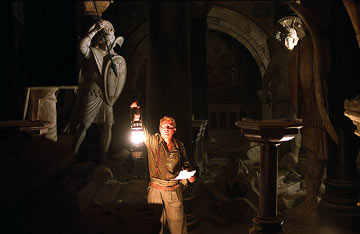

There are two things that come into play when looking at Exorcist: The Beginning. The first is as the prequel to 1973's The Exorcist, quite possibly the scariest movie ever made. The second is as a standalone horror film. It doesn't do too well as the latter, and pales in comparison to the former. After the wild success of the re-release of The Exorcist, events were set into motion to make this prequel, which sheds light onto what happened to Father Lankester Merrin, memorably played by Max von Sydow, years ago in Africa. The first Exorcist film was so memorable because it used a combination of graphic and psychological horror to scare the pants off its audience. While the audience could not identify with a little girl who could turn her head 360 degrees and spit out pea soup, it could identify with some of the issues raised. This is where most horror films fail today. They just throw out blood and gore, or add in moments to make people jump. There is little out there that will truly frighten people. Director Renny Harlin (Driven, Deep Blue Sea) opted to ignore any deeper issues, and just throw out blood on the screen.
Harlin is the third director attached to this film, and the history of its troubled production is enough to merit its own movie. The first director attached was John Frankenheimer, who worked on the film for a year, backed out, then died. Liam Neeson was originally set to star, then he backed out. Then, Paul Schrader (Auto Focus, Forever Mine) was hired to direct, and Stellan Skarsgard (King Arthur, Dogville), who actually resembles von Sydow, came aboard as Merrin. After completing the film, Morgan Creek fired Schrader, and hired Harlin. Harlin threw out most of the film, kept Skarsgard, made some cast changes, and upped the blood and gore while toning down dialogue and story elements. Then he got hit by a car during production. Oddly enough, Morgan Creek is going to release Schrader's version (supposedly more "psychological") later this year on DVD.
Exorcist: The Beginning does have a fractured feel to it, and nobody will know if this is because of the Schrader/Harlin editing until after seeing both versions. It finds Merrin as a man who lost his faith, now working as an archaeologist. Memories of what he did during World War II continue to haunt him, and force him to question if there is a God, and if so, why He abandoned Merrin. Merrin is investigating the discovery of a buried church in Kenya. The only problem is that the church was built in the 5th Century, which was over 1,000 years before the Christianity arrived in that region. At the site is evidence of a plague that happened years ago when others tried to excavate, and Sumerian symbols (which the film never explains). Father Francis (James D'Arcy, Master and Commander: The Far Side of the World, Revelation) is the local Catholic priest, and Sarah (Izabella Scorupco, Reign of Fire, Vertical Limit) is the doctor overseeing the locals. Things quickly begin deteriorating. The local Turkana tribesmen believe that there is an evil in the Church, and that excavation has awakened it. The last archeologist went insane, and now, a young boy (Remy Sweeney) has fallen into a trance and is exhibiting extremely strange signs (like he's…dum dum dum…possessed?)
Harlin quickly takes things downhill from there. As a director, Harlin has never been one known for his subtlety. He favors big explosions and loud crashes. The beginning of The Exorcist: The Beginning works because everything is shrouded in shadows, creepy and moody (although it is annoying how Merrin keeps doing things like digging up graves and exploring underground caverns at night. Harlin and screenwriter Alex Hawley, working off a story by William Wisher Jr. (The 13th Warrior, Judge Dredd) and Caleb Carr then proceed to throw any semblance of intelligence out the window to favor typical horror movie conventions and some random, over-the-top violence. It's particularly sad given the pedigree of the film and that things are going pretty well for the first part of it.